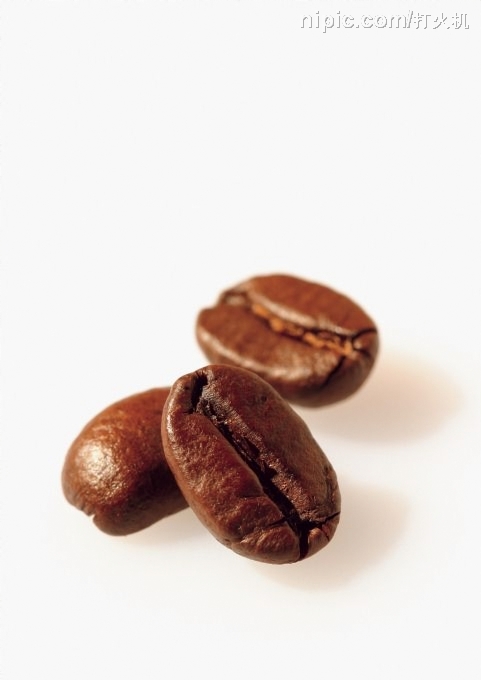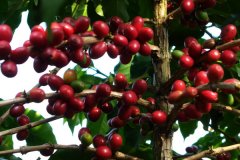Aren't the oiled coffee beans fresh?

Oiled coffee beans, deeply roasted
Have you ever seen oily coffee beans? Why do some coffee beans have a shiny surface, while others are "dry and comfortable" without greasy? What is the relationship between the "oil" of coffee beans and the freshness? Should we buy coffee beans that are "oily" or "unoiled" in appearance?
Coffee oil that is not oil.
These "oils" distributed evenly on the surface of coffee beans are actually not "oils", but water-soluble organic substances that look like oils. "Coffee oil" itself contains many aroma ingredients of coffee, which can be dissolved in water, so the surface of your brewed coffee will not float.
A layer of greasy grease.
There are two reasons for "oily beans".
There are two reasons for "oily beans". A stale shallow baked beans b fresh deep baked beans. The following in-depth discussion.
A) stale moderately baked beans
The "medium-light baked beans" with light roasting heat and light brown appearance are dry and will not produce oil after baking. About six days after baking, the phenomenon of "dotted oil" begins to appear (dotted oil droplets appear on one side of the coffee bean). Slight "dotted oil" does not mean that it is not fresh, but sometimes the flavor of medium-shallow roasted coffee beans is at its peak. Continue to put, more than two weeks after the oven, the surface of medium-shallow baked beans gradually appeared a layer of bright oil, at this time, the flavor of "medium-shallow baked beans" has begun to decline, should avoid buying.
B) fresh deep baked beans
Deep-baked beans with dark brown appearance show a slight glossy appearance after baking, and a large amount of oil begins to appear on the surface from the second day to the fifth day after baking. The bright-looking "deep-baked beans" not only do not mean that they are not fresh, on the contrary, the deep-baked beans will gradually dry out three weeks after they come out of the oven, and finally become dry-flavored beans. Therefore, if you see coffee beans that are dry but dark brown in appearance, please pay special attention to their baking date, which is most likely to be spoiled beans.
The method of judging the freshness of coffee beans
Even if it is not fresh, the appearance of the "shallow baked beans" will gradually dry out after a long time (such as three months), and finally return to the dry and unoily appearance. Thus it can be seen that whether the appearance is oily or not is just to judge whether the coffee beans are new or not.
How should we judge the freshness of coffee beans?
First of all, you should choose and buy coffee roasters with brand reputation and emphasis on fresh roasting, and avoid buying coffee beans with unknown freshness. Point the exhaust valve at the nose, gently squeeze the coffee bag and smell the gas. If it is a charming and fragrant coffee aroma, the freshness will not be a problem. On the contrary, if it does not smell strong enough, or even smells of smelly oil, it means that this bag of coffee has already gone bad and should be avoided.
Conclusion-
"the appearance of freshly baked shallow baked beans should be dry and oil-free, and the surface of freshly baked deep baked beans should be shiny" is the correct concept that we should understand. When buying coffee beans, the appearance of oil, no oil is a reference index to judge the freshness, but not absolutely. The best policy is to buy reputable freshly roasted coffee beans.
Important Notice :
前街咖啡 FrontStreet Coffee has moved to new addredd:
FrontStreet Coffee Address: 315,Donghua East Road,GuangZhou
Tel:020 38364473
- Prev

Coffee roasting
The growth environment of boutique coffee beans also has higher requirements. Generally grow at an altitude of 1500 meters or even more than 2000 meters above sea level, with appropriate precipitation, sunshine, temperature and soil conditions. Some world-famous coffee beans also have a special geographical environment, such as the alpine clouds in the Blue Mountains, the free shade provided by the afternoon clouds in Kona, and the volcanic ash soil in Antigua.
- Next

What are the top coffee beans?
The deep-roasted coffee (Gourmet) category caters to the tastes of the most demanding gourmet. Including the production process, this coffee is favored by diners, the taste is clean and meticulous, with a slightly sour taste, not strong but very long-lasting, her unique sweet melon and fruit aroma will give off a perfect taste after cooking; excellent balance, taste saturated, strong, smooth taste, mellow taste
Related
- Guji coffee producing area of Guji, Ethiopia: Humbela, Shakiso, Wulaga
- What is the most expensive variety of Qiloso in BOP multi-variety group?
- How to store the coffee beans bought home?
- Why are Yemeni coffee beans so rare now?
- Ethiopian Sidamo all Red Fruit Sun Sun Santa Vini Coffee beans
- SOE is mostly sour? What does it mean? Is it a single bean? what's the difference between it and Italian blending?
- Is Italian coffee beans suitable for making hand-brewed coffee?
- How to choose coffee beans when making cold coffee? What kind of coffee beans are suitable for making cold coffee?
- Just entered the pit to make coffee, what kind of coffee beans should be chosen?
- Can only Japan buy real Blue Mountain Coffee? What are authentic Jamaican Blue Mountain coffee beans?

